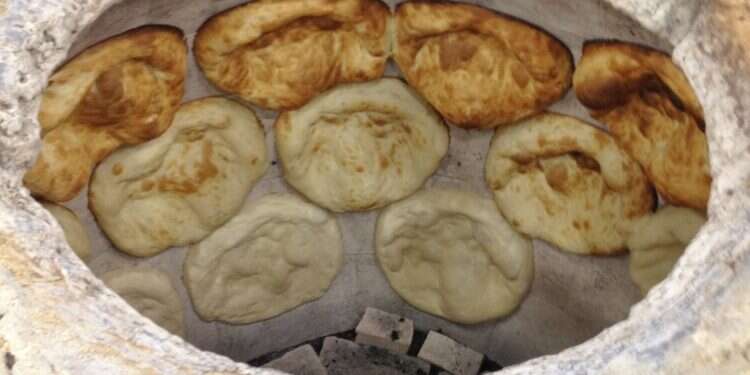Every summer, religious travelers flock to destinations around the world.
In the first of a series of articles for the wandering religious traveler, Rabbi Oren Duvdevani of Tzohar explains how to keep kosher while visiting Georgia (the country, not the US state).
In recent years, in large part due to the relatively short flight time (two hours and 25 minutes), the Georgian countryside has attracted increasing numbers of Israeli tourists looking for a quick and enjoyable getaway.
Travelers enjoy the remarkable natural vistas, local communities of Jews and non-Jews alike who warmly welcome tourists from around the world, as well as the nation's famed Mediterranean cuisine.
The small mountainous country bordered by Russia, Azerbaijan, Turkey, and Armenia is renowned for a culinary tradition that has become increasingly popular among Israelis following the influx of immigrants in recent decades from the Georgian region. The obvious main difference between the local Georgian meals and those appreciated by many Israelis is adherence to kashrut, both in terms of the ingredients used and keeping meat and milk products separate in food preparation.
Georgians have a very diverse palate and are known for preparing rich meat and vegetable dishes including soups and stews.
But the basis of most Georgian meals are some simple staples of locally sourced breads and cheeses.
For a religious traveler who wants to benefit from the natural wonders this country has to offer while also embracing the local foodie culture, the question becomes what breads can he or she eat while strictly adhering to kashrut.
To answer this question, we turned to Rabbi Oren Duvdevani, an expert in kashrut in industrial food preparation and director of the Tzohar rabbinical organization's Food Supervision agency.
"Kashrut is generally divided into three main categories," he explains. "Kashrut of the raw ingredients, kashrut of the equipment and kashrut in how the food is prepared. In most parts of the world, it's difficult to find kosher breads because the source ingredients are problematic. In Mexico, for example, government regulations require adding milk to bread so nearly all breads are dairy. In other countries, there are additives put into the bread that originate in live animals or other potentially problematic sources or even alcohol-based additives that are prohibited for kosher consumption.
"In order to be the best possible mashgiach (kashrut supervisor), I always say that the supervisors should be watching local culinary and food programs so that they can understand the culture because if you are dealing with kashrut it's critical to have an in-depth appreciation for how food is prepared and why it's done in specific ways in specific places. Just an example – if a mashgiach doesn't understand that sugar-free products typically require some other ingredient to add sweetness and that ingredient could be problematic then they won't be on the lookout for these types of issues. In my estimation, everyone needs to work to obtain a broad appreciation for how food is prepared because that is the best education to avoid problems in kashrut. People often ask 'What could possibly be in a loaf of bread?' and that's because they don't know that on average bread has some thirty different ingredients beyond flour and water. That lack of knowledge leads people to the wrong conclusions."
So returning to Georgia as our case study, it turns out that the issue is relatively simple.
"The Georgian approach to baking is very traditional and interestingly the older the approach is, typically we see fewer problems in terms of kashrut," Duvdevani explains. "Travelers are likely to encounter three bread types which can be largely distinguished based on their shape. The tonis puri is a shallow type of bread that is similar to our pita and takes its name from the oven where it is baked. Its sole ingredients are flour and water so there shouldn't be kashrut issues relating to the ingredients but it does have the designation of 'pat nochri' – which means it has been prepared by a gentile. Another type of bread is called shotis puri and has more of a canoe-like shape. It also shouldn't contain nonkosher ingredients and is very widely found in former Soviet counties and even in Moscow it can be purchased and likely to be kosher. The main problems surround the third type of bread called khachapuri that often includes nonkosher cheeses among its ingredients. There are as many as seven different types of khachapuri with different fillings and each is attached to a specific geographic region."
So if a traveler arrives in a small Georgian village, can they eat the basic bread and assume it's kosher?
"For those who will be traveling into the small villages, you are likely to encounter the women who are preparing these breads and you will need to know if they are being prepared alongside other foods that might not be kosher. If the oven is solely for bread with kosher ingredients then there is no problem but if the oven cooks other potentially nonkosher foods then it needs to be avoided. But even when all the ingredients and equipment are fine and the food preparation is done in a kosher manner, you encounter the problem of 'gentile bread' which is prohibited under rabbinic law. If it's a small local place, you can ask to join in the baking process and address that problem or in larger places there are halachic bases for leniency. But in general, the best option is to seek out those basic breads that shouldn't have any other ingredients beyond flour, water, and salt and contain no additives other than what is naturally contained in the flour."
Most of all, is it tasty?
"For sure. When it's hot and fresh it tastes great and will remind the traveler of their favorite breads from back home."
Enjoy!




